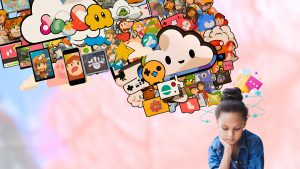
In the midst of a global pandemic, political uncertainty, lockdowns and social unrest, children and teens are experiencing an unprecedented mental health crisis. Children and Screens: Institute of Digital Media and Child Development has asked interdisciplinary experts to share their cutting-edge research and provide clinical advice to help parents identify, understand and address emotional, psychological and behavioral issues in children’s and teens’ digital lives.
Time’s Up
Parental control settings on devices are helpful, but in order to be effective, they need to be accompanied by direct supervision and active engagement, as well. Discuss limits on screen time with children when you have their full attention, and seek their input when creating the rules. Give children a 5-15 minute warning before they need to turn off their devices, and if they fail to log off at the appropriate time, decrease their screen limits for the next day as a consequence. Children may react poorly or with tantrums in the short term, but if parents are firm and stick to their limits, this behavior will improve. – Paul Weigle, MD, Child and Adolescent Psychiatrist and Chair of the Media Committee of the American Academy of Child and Adolescent Psychiatry
Aged to Perfection
It’s wise to set limits and have agreements with your children regarding screen use, but don’t forget to take each child’s age and stage of development into consideration. For example, children under 18 months really shouldn’t use screens at all, and, though it’s difficult during these unusual times, parents should also limit screen time for children between the ages of 2-5. For older children, prioritize what they must use screens for—schoolwork and connecting with peers—and then agree on an appropriate amount of time for entertainment. Keep in mind that social media networks like TikTok, Snapchat and Instagram require users to be at least 13 to sign up. – Diana Graber, author of “Raising Humans in a Digital World: Helping Kids Build a Healthy Relationship with Technology,” and founder of Cyberwise and Cyber Civics.
Socialization, Self-regulation, & Safety
Using the framework of the three Ss – healthy socialization, effective self-regulation, and overall safety – is a solid structure to develop collaborative solutions with your child. Healthy socialization encourages children and teens to opt-in to energizing experiences online and in-real-life, and opt-out of toxic or draining ones, and parents can help kids identify the difference. Effective self-regulation is all about developing and implementing rituals and strategies to encourage positive, pro-social use and avoid incremental slide into overuse. Finally, overall safety looks at not just physical safety, but social and emotional wellness as well. It also looks at data and privacy issues, and allowing kids the autonomy to make choices about how and where they will participate and share online. – Ana Homayoun, author of “Social Media Wellness: Helping Tweens and Teens Thrive in an Unbalanced Digital World,” Founder, Green Ivy Educational Consulting
Build Balanced Boundaries
It’s important to set boundaries around screen time, but it’s just as important for parents to cut themselves some slack during these challenging days. Strict screen limits can result in more stress and conflict for families, so parents should be flexible and recognize that, when balanced with non-screen activities, unstructured screen time can be an important source of comfort for children. It can also be used as a reward to promote positive behaviors (i.e. outdoor activities, playing games with the family, helping with chores around the house). If your kids claim they don’t have anything to do, try creating an activity menu of offline ideas or setting a schedule with consistent routines. In addition, it’s essential for parents to model healthy screen use themselves. – Paul Mitrani, MD, PhD, Clinical Director, Child Mind Institute; Child and Adolescent Psychiatrist
Plan Ahead
It’s critical to have a conversation with your teen about healthy social media use before they get their own smartphone or start using social media. Discuss what they’ll do (and what you’ll do) if they experience conflict online (e.g., cyber-bullying or pressure to send photos or messages) or if their social media use appears to be interfering with their normal functioning. Two questions I find helpful to ask teens are: (1) “How will we know if your social media use becomes problematic?” and (2) “What can you do to make sure social media is something enjoyable (and not stressful)?” Don’t worry if your teen already uses social media and has their own phone—it’s never too late to talk about how social media engagement is contributing to their wellbeing. – Sarah E. Domoff, Ph.D., licensed psychologist and Associate Professor in the Department of Psychology at Central Michigan University (CMU) and Research Faculty Affiliate at the School of Public Health at the University of Michigan.
Keep It Real
Following actual friends on social media is correlated with lower levels of depression and loneliness, but following strangers is correlated with just the opposite. It’s hard to remember that influencers and celebrities’ heavily curated feeds don’t reflect reality, which can leave you feeling bad about your own life. Instead of following strangers, use Facebook, Instagram, and Snapchat to stay connected and have real conversations with people you know and care about. Interact by posting yourself and commenting on their posts. Show the authentic, full range of your life (both the good and the not so great), and use these platforms as a way to stay connected, especially when we have to remain socially distant. – Melissa G. Hunt, PhD, Associate Director of Clinical Training in Psychology at the University of Pennsylvania
Feed Your Feed With Positivity
We often make the mistake of thinking that social media is a uniform, homogenous experience and that it is, as a whole, either good or bad for young people. In reality, social media is like any of our other social interactions—it can leave us feeling elated and empowered or demoralized and self-conscious. When we encounter support, kindness, and joy online, we likely walk away in a very different state than if we’d encountered aggression, negativity, or cruelty. Parents can remind their children that they can declutter their social media feeds by unfriending or unfollowing people whose posts and messages are insulting or unkind. We can go even farther by empowering kids to question the curated versions of their friends’ lives they see and to challenge opinions and perspectives shaped by modern marketing strategies. – David Bickham, PhD Center on Media and Child Health, Boston Children’s Hospital
Get Their Help
Helping parents with a household project is a great way for kids and teens to set aside their devices and gain a sense of accomplishment. When a young person has a project (like gathering old toys to take to a donation center or gardening), it builds confidence and engages the mind in a tangible activity, which can help reduce anxiety or depression. The mood boost is strongest for projects that are outside. The sense of accomplishment that comes from these projects can also help alleviate social comparison and the fear of missing out while remaining safely socially distanced during the pandemic. It’s no problem to listen to music or a podcast while working on a project, but screens should be set aside until the job is completed. When finished, be sure to praise and thank your child for their contribution to the household and help them recognize the good work they’ve done. – Susan Tapert, PhD, Professor of Psychiatry at University of California, San Diego
Social Planner
Parents are understandably concerned about children’s difficulty setting limits on their use of technology. Our first impulse is often to radically restrict kids’ use of video games and social media without first attempting to understand why they appeal so much to children. Minimize young children’s exposure to technology, but, once kids start, learn about the games and apps they like, show interest in them, and participate whenever possible. It’s much easier to influence children’s (especially teens’) use of technology when we treat them respectfully. We want to work with kids, not against them, to help them manage for themselves their use of powerful and omnipresent technologies. – Ned Johnson, co-author of “The Self-Driven Child: The Science and Sense of Giving Your Kids More Control Over Their Lives.”
Quality Over Quantity
For years, parents have been told to police their children’s screen time, but with the onset of COVID-19, kids are suddenly forced to rely on their devices more than ever. Experts now argue that it’s not the amount of time children engage with screens that matters so much as the quality of that engagement. First, consider the context: are your kids engaging with a screen to avoid their schoolwork, or to relax because they’ve completed it? Second, consider the content: what are your children watching? Do you think it has value? Do they? Lastly, consider the social connections: are your children using technology to sustain valued relationships (from video-chat with grandparents to talking to friends while playing a video game), or not? – Sonia Livingstone, PhD, author of Parenting for a Digital Future: How Hopes and Fears About Technology Shape Children’s Lives
Family Matters
With COVID-19 limiting children’s real-world peer connections, parents may believe that kids need to spend their days online chatting with friends, but science reveals that family connections matter more for children than peer connections, even for teens. That means you should feel good about limiting your kids’ use of digital media in order to encourage their engagement with family. – Richard Freed, Ph.D., psychologist and author of Wired Child: Reclaiming Childhood in a Digital Age
Log Off and Let Loose
I recently read in the newspapers that children are playing outside less and less these days. This is a real pity, because when playing outside with friends, children are both physically active and socially active, which helps them relax in a natural way. What a nice counterbalance to sitting inside for hours and hours, almost rudderless, in a cramped position, playing games on the screen, bathing in sweat from the stress of not to get a higher ‘level.’ – Prof. Guido Van Hal, Social Epidemiology, University of Antwerp, Belgium
*****************************
The experts agree; screen use can have profound impacts on children’s mental health, both positive and negative. It’s essential that parents pay attention to what their kids do online and encourage productive online behavior along with meaningful offline activities. There’s no one-size-fits-all solution when it comes to screen time, especially during a pandemic, but by showing an interest in their children’s digital lives and setting clear boundaries (while remaining flexible), parents can find a healthy balance ideally suited to their family.
About Children and Screens
Since its inception in 2013, Children and Screens: Institute of Digital Media and Child Development, has become one of the nation’s leading non-profit organizations dedicated to advancing and supporting interdisciplinary scientific research, enhancing human capital in the field, informing and educating the public, and advocating for sound public policy for child health and wellness. For more information, see www.childrenandscreens.com or write to info@childrenandscreens.com


